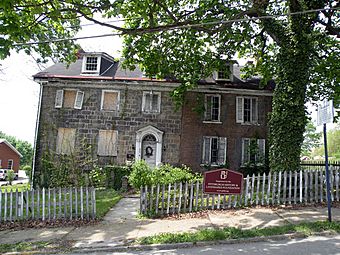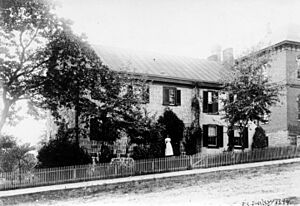Roberts House (Canonsburg, Pennsylvania) facts for kids
Quick facts for kids |
|
|
Roberts House
|
|

Roberts House in 2010
|
|
| Location | 225 N. Central Ave., Canonsburg, Pennsylvania |
|---|---|
| Area | 0.2 acres (0.081 ha) |
| Built | 1800 |
| Architectural style | Georgian, Post Colonial |
| NRHP reference No. | 75001674 |
| Added to NRHP | April 10, 1975 |
The Roberts House is a very old and important building in Canonsburg, Pennsylvania. It is listed on the National Register of Historic Places, which means it's officially recognized for its historical value. It's also a special landmark for Washington County. A historical marker stands near the house. This house is the last building left from the original Jefferson College.
The story of the Roberts House goes back to the early 1800s. It was connected to Colonel John Canon, who founded Canonsburg, and Reverend John McMillan, who started Jefferson College. Over more than 200 years, the house was sold many times. Often, it was bought by people linked to Jefferson College. In 2006, a group tried to restore the house. They got some money, but the project has been slow.
Contents
Building the Roberts House
The first part of the Roberts House was made of wood. It had two stories and was about 18 feet by 22 feet. This size was normal for homes in the area back then. In 1798, a tax was placed on windows. At that time, the house had 78 panes of glass across seven windows.
Later on, more sections were added to the house. These new parts were built using stone.
Early Life at Roberts House
The land where the Roberts House stands was first given to Colonel John Canon. He was the person who founded Canonsburg. On February 3, 1796, Canon gave the land to Reverend John McMillan. Reverend McMillan was the founder of Jefferson College.
By 1798, John Watson lived in the house. He was a professor at Jefferson College and later became its first president. In 1803, a man named John Roberts bought the property. The house is named after him. He ran a store there.
The house was sold many times after that. Abraham Lattimore bought it in 1815. Then, Joseph Pentecost, a lawyer from Washington, bought it in 1817. David Hoge bought it in 1819, and Alexander Short in 1829. Short also ran a store in the house.
In 1832, Short lost the property in a special sale. John K. Wilson then became the owner. In 1840, Wilson traded the house with Matthew Brown. Brown was the president of Jefferson College. He gave Wilson five lots of land in Washington and a small amount of money.
President Brown then gave the house to Jefferson College. For a while, William Smith lived there. He was a professor of Greek and the vice-president of Jefferson College. After Jefferson College joined with Washington College, the house belonged to Jefferson Academy.
In 1882, the academy sold the house to John Boon. He used it as his family home. By 1894, two sisters, Bettie and Natalie Snyder, lived there. They were school teachers and their father, Henry Snyder, was a professor at Jefferson College. Another person who lived there was Catherine Munnell Croker. She taught piano and played the organ at a local church.
Saving and Restoring the House
The Roberts House was studied by an expert named Charles Morse Stotz in 1936. He wrote a book about old buildings in Western Pennsylvania. The details he recorded about the Roberts House helped guide later efforts to fix it up.
In the early 1970s, a survey of old buildings was done in Washington County. The Roberts House was part of this survey. This study helped the house get listed on the National Register of Historic Places in 1975. This listing helps protect important historical places. Another study of the house was done in 1981.
In 2006, two groups, the Washington County Cultural Trust (WCCT) and the Pittsburgh History and Landmarks Foundation, made a plan. They wanted to restore the Roberts House and turn it into a center for arts in the region. As part of this plan, a trustee from WCCT bought the house in December 2006. He then sold it to the Pittsburgh History and Landmarks Foundation. The idea was for the foundation to hold the house for a year. During that time, WCCT would raise money to fix it.
The building was in bad shape, especially the roof. To start raising money, WCCT got $5,000 from local government leaders. On August 15, 2008, something sad happened. The house was badly damaged by vandals. They broke a valuable cherry wood stair railing and an old mirror. The damage cost a lot of money to fix.
In 2009, during Halloween, local history fans held a "Haunted History Walk." This event helped raise money for the restoration. Also in 2009, the Pennsylvania Department of Community and Economic Development gave over $218,000 for the renovation project. This money came from a local casino.
Images for kids
- National Register nomination form





